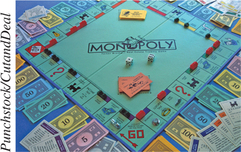EXAMPLE 7 Finding probabilities for the experiment of tossing two fair dice

Imagine that you are playing Monopoly with your dormitory roommate, and the loser has to do the laundry for both of you for the rest of the semester. You have a hotel on Boardwalk, and if your roommate lands on it, you will surely win. Right now your roommate’s piece is on Short Line: if he or she rolls a 4, you will win and get your laundry done free for the remainder of the semester. Put into statistical terms, the experiment is to toss two fair dice and observe the sum of the two dice. Find the probability of rolling a sum of 4 when tossing two fair dice.
Solution
It is reasonable to assume that each of these N(S)=36 outcomes in the sample space (Figure 3) is equally likely. The experiment of tossing two dice can be viewed as a two-stage experiment, where we add the result from the first die to the result from the second die. If a 5 appears on the first (say, dark green) die, and a 3 appears on the second (light green) die, the overall outcome is (5,3), with the resulting sum equal to 8. Note that the outcome (5,3) is not the same as the outcome (3,5), where the dark green die comes up 3 and the light green die comes up 5.

Let E denote the event that your roommate rolls a sum equal to 4. Then the outcomes that belong in this event are E:{(3,1)(2,2)(1,3)}, so N(E)=3. The outcomes are equally likely, so we can use the classical method for finding probabilities of events.
P(E)=number of outcomes in Enumber of outcomes in sample space=N(E)N(S)=336=112
The probability that your roommate will land on Boardwalk on this throw of the dice is 1/12.
NOW YOU CAN DO
Exercises 43–50.